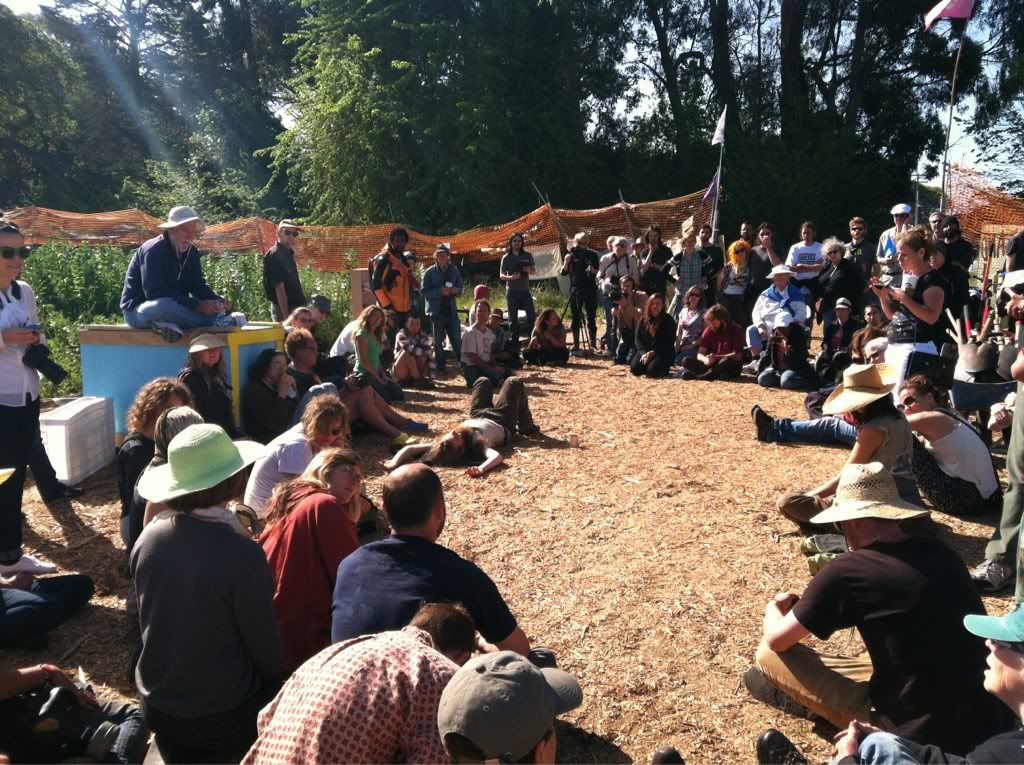To those who had become accustomed to seeing the Occupy movement build its camps in squares and buildings, the occupation of a farm seemed a curious choice for the protest group. However, the truth is Occupy the Farm is arguably one of OWS’s most important offshoots—a movement that not only draws attention to the rotten corporate practices of Big Ag but also focuses on issues near and dear to Occupy’s heart, such as the environment and overall health of society.
Media coverage of superbugs, food recalls and pink slime meat have all brought the issue of bad food production to the forefront in American culture. Yet the issue of food sovereignty not only includes safety, but also access, and this concerns everyone even if they’re not a farmer. As the author and farmer Wendell Berry once wrote, “If you eat, you are involved in agriculture.”
According to the Obama administration’s Health Food Financing Initiative, about 23.5 million Americans live in low-income areas that are more than one mile from a supermarket. Unfortunately, sometimes the so-called “solution” proposed to alleviate this crisis is to build a Walmart, which will indeed sell produce, but that produce is unlikely to come from a local, sustainable farm. The result may be the alleviation of one problem (food deserts) but at the cost of worsening other areas (food safety, sustainability, environment) while quietly tolerating Walmarts already legendary mistreatment of workers.
Another way to think of food sovereignty is in terms of food security. La Via Campesina, an international movement that coordinates peasant organizations of small producers, agricultural workers, rural women and indigenous communities from Asia, Africa, America and Europe, defines food sovereignty as “the right of people to define agriculture and food policy, including prioritizing local agricultural production, access of peasants and landless people to land, water, seeds, and credit.”
If our society eats better and ensures the sovereignty and dignity of the people growing our food, we all grow stronger.
 Keeping with all of these themes, OTF activists moved onto the Gill Tract, a patch of land along the San Pablo Avenue in Albany on Earth Day, April 22, and they’re asking that UC Berkeley preserve part of the tract for agricultural study and urban farming. (photo by @chrismyee)
Keeping with all of these themes, OTF activists moved onto the Gill Tract, a patch of land along the San Pablo Avenue in Albany on Earth Day, April 22, and they’re asking that UC Berkeley preserve part of the tract for agricultural study and urban farming. (photo by @chrismyee)
“We envision a future of food sovereignty,” OTF states on its website, “in which our East Bay communities make use of available land—occupying it where necessary—for sustainable agriculture to meet local needs.”
Popular
"swipe left below to view more authors"Swipe →
But why this particular farm? OTF explains:
“These are the last acres of Class One soil left in the urbanized East Bay. Ninety percent of the original land has been paved over and developed, irreversibly contaminating the land.”
The group goes on to detail how students, professors and the community have fought for decades to save the land from development so they could use it for sustainable agriculture, but UC Berkeley currently administers the land and has it slated for rezoning and redevelopment, i.e., building supermarkets (ironically, a Whole Foods), parking lots, apartments etc. in 2013. Furthermore, the university uses the land to research corn genetics, which OTF claims can be done anywhere, as opposed to this unique site.
The standoff between UC Berkeley and OTF has led to some bizarre coverage of the farm rejuvenation, including the San Francisco Chronicle’s accusing the activist farmers of planting “renegade crops.”
Professor Migel Altieri, researcher at the Gill Tract for thirty-one years, planned to begin planting his research plot with his students this week, but an hour before he was scheduled to begin, the UC administration barricaded the Gill Tract with concrete, metal barriers and dozens of police who threatened farmers with “chemical agents and impact force,” according to Altieri.
View more videos at: http://nbcbayarea.com.
Despite the blockade, Altieri and the activist farmers did manage to plant a small part of his organic, drought-resistany crops that the activists say have benefited East Bay soup kitchens for years.
 The university has taken the additional step of filing a lawsuit against fourteen of the occupiers, demanding they leave the property and reimburse the university for legal costs. (photo of police locking farm gates by @Chrismyee)
The university has taken the additional step of filing a lawsuit against fourteen of the occupiers, demanding they leave the property and reimburse the university for legal costs. (photo of police locking farm gates by @Chrismyee)
A UC spokesman named Dan Mogoluf said there is a “plan on the table” that would allow urban gardening and university research to continue, and in a statement released Tuesday, the university said leaders have sat down with protesters and “discussed steps that would allow for a peaceful end to the illegal occupation.”
One of the activist farmers, Lesley Haddock, wrote an article about her experience at Gill Tract for Occupy.com.
She opens the article by stating, “Before our project began, I had never planted a seed, but in the past two works, I have become a farmer.” (photo of activist farmers by @yvonnegraphy)

In the past two weeks, our little collection of activists and students has grown into a family of farmers. I am awed. As the time to begin the farm drew closer, I was the one in the meetings arguing that we could not just lead 200 urban dwellers onto a piece of land, shout “let’s plant!” and then expect them to build a farm from scratch. I was so wrong. Within 10 minutes of walking onto the Gill Tract, hundreds of people had spread out across the fields, weeding and tilling soil. By the end of the day, we had a farm. Two weeks later, more people have become farmers on this public land than had set foot on it in all the years of U.C. ownership combined.
Haddock closes by saying the farm aims to be an asset to the broader East Bay community.
“With thousands of local families living in food deserts with no access to fresh produce, this farm is an attempt to address the growing threat of food insecurity,” she writes, adding “In this spirit, today I wake up as a farmer.”


